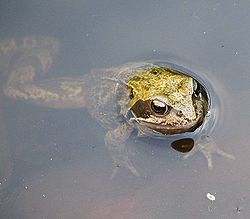
Back ذوات الدم البارد Arabic Wechselwarmes Tier German جانور خونسرد FA Poïkilotherme French בעלי דם קר HE Սառնարյուն կենդանիներ HY პოიკილოთერმული ცხოველები KA Пойкилотермдик организмдер KY Aukstasiņu dzīvnieks Latvian/Lettish Zwierzę zmiennocieplne Polish
This article needs attention from an expert in biology. The specific problem is: Article could have a lot more information. (July 2016) |
| Thermoregulation in animals |
|---|
 |

A poikilotherm (/ˈpɔɪkələˌθɜːrm, pɔɪˈkɪləˌθɜːrm/) is an animal (Greek poikilos – 'various', 'spotted', and therme – 'heat') whose internal temperature varies considerably. Poikilotherms have to survive and adapt to environmental stress.[1] One of the most important stressors is outer environment temperature change, which can lead to alterations in membrane lipid order and can cause protein unfolding and denaturation at elevated temperatures.[1] Poikilotherm is the opposite of homeotherm – an animal which maintains thermal homeostasis. In principle, the term could be applied to any organism, but it is generally only applied to vertebrate animals. Usually the fluctuations are a consequence of variation in the ambient environmental temperature. Many terrestrial ectotherms are poikilothermic.[2] However some ectotherms seek constant-temperature environments to the point that they are able to maintain a constant internal temperature, and are considered actual or practical homeotherms.[3] It is this distinction that often makes the term poikilotherm more useful than the vernacular "cold-blooded", which is sometimes used to refer to ectotherms more generally.
Poikilothermic animals include types of vertebrate animals, specifically some fish, amphibians, and reptiles, as well as many invertebrate animals. The naked mole-rat[4][5] and sloths[6] are some of the rare mammals which are poikilothermic.
- ^ a b Guschina, Irina A.; Harwood, John L. (2006). "Mechanisms of temperature adaptation in poikilotherms". FEBS Letters. 580 (23): 5477–5483. Bibcode:2006FEBSL.580.5477G. doi:10.1016/j.febslet.2006.06.066. ISSN 1873-3468. PMID 16824520. S2CID 25197515.
- ^ Hildebrand, Milton; Goslow, G.E., Jr. (2001). Analysis of Vertebrate Structure. Hildebrand, Viola (principle illust.). New York, NY: Wiley. p. 429. ISBN 0-471-29505-1.
{{cite book}}: CS1 maint: multiple names: authors list (link) - ^ Riemer, Kristina; Anderson-Teixeira, Kristina J.; Smith, Felisa A.; Harris, David J.; Ernest, S.K. Morgan (2018). "Body size shifts influence effects of increasing temperatures on ectotherm metabolism". Global Ecology and Biogeography. 27 (8): 958. Bibcode:2018GloEB..27..958R. doi:10.1111/geb.12757.
- ^ Daly, T.J.M.; Williams, L.A.; Buffenstein, R. (1997). "Catecholaminergic innervation of interscapular brown adipose tissue in the naked mole-rat (Heterocephalus glaber)". Journal of Anatomy. 190: 321–326. doi:10.1046/j.1469-7580.1997.19030321.x. PMC 1467613.
- ^ Sherwin, C.M. (2010). "The husbandry and welfare of non-traditional laboratory rodents". In Hubrecht, R.; Kirkwood, J. (eds.). UFAW Handbook on the Care and Management of Laboratory Animals. Wiley-Blackwell. Chapter 25, pp. 359-369.
- ^ Britton, S.W.; Atkinson, W.E. (1938). "Poikilothermism in the Sloth". Journal of Mammalogy. 19 (1): 94. doi:10.2307/1374287. JSTOR 1374287.